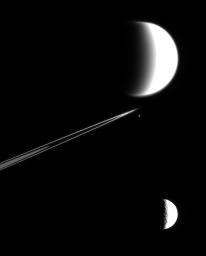
|
One View, Multiple Worlds
- Click the image above for a larger view
- Full-Res JPEG (982 x 1220) (25.1 kB)
- Full-Res TIFF (982 x 1220) (1.2 MB)
Caption:
Three very different worlds crowd the frame in this unique view from the Cassini spacecraft, which although partly overexposed, provides a splendid look at several major targets of interest for the mission.
Titan (at the top) has a thick, hazy atmosphere. Cassini has observed it to be a world where complex geological and atmospheric processes are occurring. At 5,150 kilometers (3,200 miles) across, it is Saturn's largest moon, and is the second largest moon in the solar system, after Jupiter's moon Ganymede (5,262 kilometers, or 3,270 miles across).
Tethys (at the bottom) has been battered by impacts over the eons, and some of its many craters are visible in this image. Tethys (1,071 kilometers, or 665 miles across) is one of Saturn's major icy moons, having a density close to that of water. This moon shows evidence that icy tectonic processes have occurred on its frozen surface, such as the immense canyon system called Ithaca Chasma.
Epimetheus (center) is one of Saturn's "ring moons": small, porous bodies that orbit within or just beyond the rings. Cassini acquired the closest-ever view of cratered Epimetheus (116 kilometers, or 72 miles across) in March, 2005.
Also near center are Saturn's F ring and the outer edge of the A ring to the left. In addition to the F ring's usually bright core, several other ringlets are resolved here, giving the ring a soft, wispy character that shows contrast with the more sharply defined A ring.
Appearances can be deceiving in two dimensional images like this one where it is difficult to tell which objects are in the foreground and which are farther away. In this scene, Tethys is the closest object to Cassini, at 1.2 million kilometers (700,000 miles) away. Epimetheus is on the near side of the rings and is 1.4 million kilometers (900,000 miles) distant. The giant moon Titan is 2.7 million kilometers (1.7 million miles) away, more than twice as far from Cassini as Tethys.
This view is a mosaic of two images taken in visible light with the Cassini spacecraft narrow-angle camera on Feb. 19, 2005. The image scale in the scene ranges from 16 kilometers (10 miles) per pixel on Titan to 7 kilometers (4 miles) per pixel on Tethys.
Background Info:
The Cassini-Huygens mission is a cooperative project of NASA, the European Space Agency and the Italian Space Agency. The Jet Propulsion Laboratory, a division of the California Institute of Technology in Pasadena, manages the mission for NASA's Science Mission Directorate, Washington, D.C. The Cassini orbiter and its two onboard cameras were designed, developed and assembled at JPL. The imaging team is based at the Space Science Institute, Boulder, Colo.
For more information about the Cassini-Huygens mission visit http://saturn.jpl.nasa.gov . For additional images visit the Cassini imaging team homepage http://ciclops.org .
Cataloging Keywords:
| Name | Value | Additional Values |
|---|---|---|
| Target | Titan | Epimetheus, F Ring, Ganymede, Saturn Rings, Tethys |
| System | Saturn | Jupiter |
| Target Type | Satellite | Ring |
| Mission | Cassini-Huygens | |
| Instrument Host | Cassini Orbiter | |
| Host Type | Orbiter | |
| Instrument | Imaging Science Subsystem (ISS) | |
| Detector | Narrow Angle Camera | |
| Extra Keywords | Atmosphere, Crater, Grayscale, Haze, Impact, Visual, Water | |
| Acquisition Date | ||
| Release Date | 2005-06-09 | |
| Date in Caption | 2005-02-19 | |
| Image Credit | NASA/JPL/Space Science Institute | |
| Source | photojournal.jpl.nasa.gov/catalog/PIA07518 | |
| Identifier | PIA07518 | |
